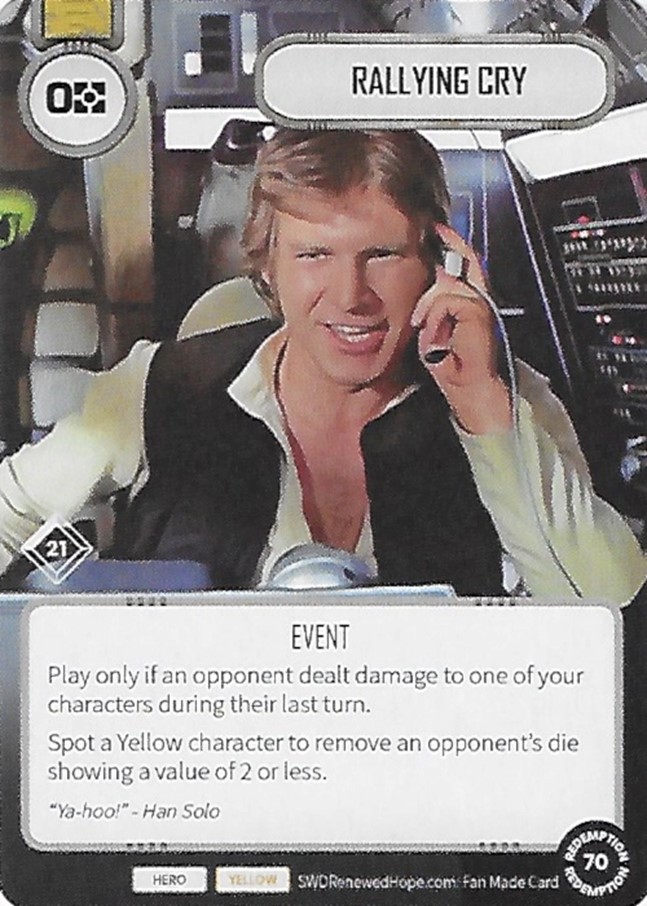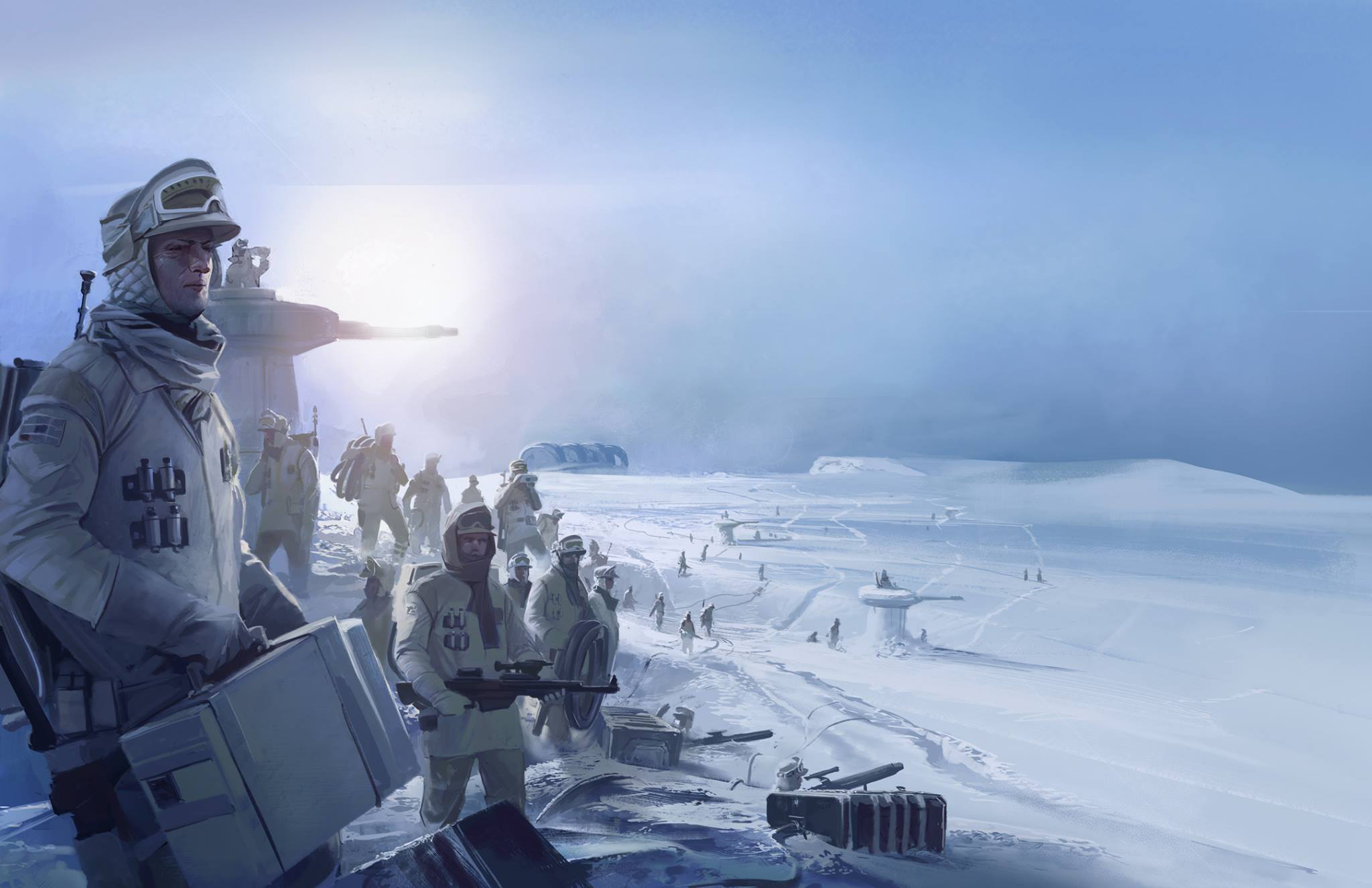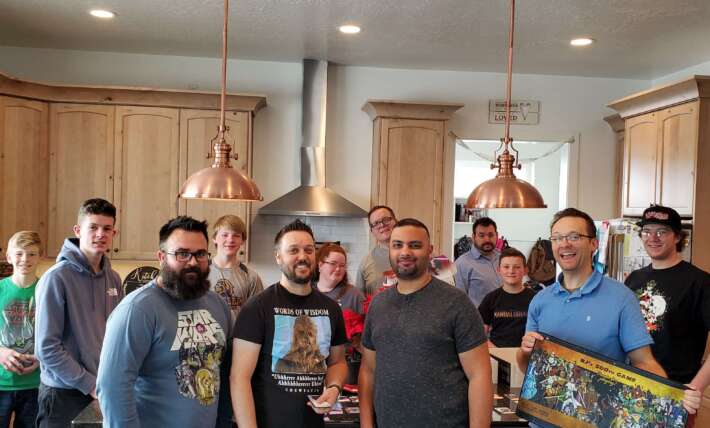Hello there,
echo7 here. As some of you in the community may know, I recently succeeded the inimitable Gandork as Chief Rules Guru for A Renewed Hope Destiny. Today I’d like to talk through a little change we’ve made to the rules, remind everyone of the fabulous resource that is the ARH Rules Reference, and share a couple of Display of Power spoilers while I’m at it. If you don’t like lots of words, there is a TL;dr version right at the bottom.
Changing the Rules of Engagement
I would never dream of attempting a major change to the rules of Destiny. However, sometimes it is necessary to make little tweaks or clarifications to ensure the game plays as intended. We have just made 1 such change and added a couple of new clarifications, and wanted to explain why.
ARH have released a number of cards that roll in set-aside dice, such as The Bad Batch, Blizzard 1, and Rally the Covert. If you had a card in your deck that used set-aside dice, you brought those dice to the game, and rolled them in from your set-aside zone when a card said you could. All good so far.
However, we’ve also made a few cards that let you play or take control of the opponent’s cards, like Data Heist, Leia Organa in Seeking Answers, and Trash to Treasure. What if someone Data Heists your Bad Batch?
The rules on Playing a Card Owned by an Opponent were quite clear: if you played a card owned by an opponent, they had to give you the matching die. However, they did not have to give you set-aside dice for that card. This made sense in a highly competitive environment. However, it never felt right in friendly Destiny, or on Tabletop Simulator where all players have access to all dice at all times.
For this reason, we have decided to subtly change the rules here. This is from the new Rules Reference:
You are now required to provide the opponent with those all important Clone Trooper and Rebel Engineer dice if they take control of or play your Bad Batch. I think this now plays out as a new player might expect: if you take control of a card, you get to reap the full benefits. I also believe this was how most players were playing this interaction anyway, especially on Tabletop Simulator, so you could think of this as the official rules catching up with how many people already play the game.
We know that there is a very slim chance that a player may pretend they do not have those dice, but consider this edge case to be highly unlikely in the friendly community of Destiny players.
This has an immediate bearing on the battlefield spoiled by our friends over at On The Sensors. If you haven’t seen the video, check it out here:
According to the old rules, if the opponent claimed this battlefield, as they weren’t allowed to bring their own copy of Jawa Scavenger die to the game, they wouldn’t get to roll your set-aside Jawa Scavenger die into their pool. Now they can. We think this is much fairer.
Matching Cards and Specials
Players of Destiny will be very familiar with special sides on dice. If you resolve a special, you need to read that die’s matching card to see what the special does. Special abilities are called Inherent Dice Abilities, a term for specials and unusual sides like those on Launch Bay or AT-RT, that you can resolve as intended even if their matching card is not in play. However, it has never been clear or necessary before to explain what happens if a die changes its matching card. It is now.
Those of us who have played Darth Bane/Darth Zannah, know that when Zannah gains all of Bane’s character dice, you need to read Darth Bane to know what the special does. However, when resolving that special ability, you can use the cost of an upgrade on Zannah as the amount of damage you were dealing to the opponent, as those dice are now “Zannah’s dice.”
The rules previously stated that Zannah did not become the matching card for these dice. Instead, the dice lived in a half-way house between being Bane’s or Zannah’s. For reasons that will become apparent later, we have decided to redefine what’s going on here in a way that has (almost) no impact on how Zannah works: we’ve decided to make Zannah the matching card for Bane’s dice after he is defeated. However, the special abilities on the dice still remain the same.
To explain this fully, we’ve edited the clarification for Zannah and we’ve added a new line to the Special Abilities section in the Rules Reference:
You can think of it as the special ability permanently written (in tiny letters) on the die.
Why this now? Well, we’ve developed this mechanic in Display of Power, and continuing with the old “another card’s dice, but still the old matching card” ruling proved to be untenable when people (you know who you are) started asking difficult questions.
To demonstrate changing matching cards in practice, I have two spoilers to share. First up, IG-RM Thug Droid:
An enforcer droid used by Cikatro Vizago, this droid guard comes in at 7 points for 7 health and carries the Guardian keyword. However, it’s his main ability that is relevant here: before this character is defeated, you can have a scoundrel you control gain this character’s die. Much like Zannah, the new scoundrel becomes the matching card for this die. While there’s no inherent dice abilities here, it’s important to highlight another useful entry in the Rules Reference:

As this die has a new matching card, this die looks to that card to determine its subtypes, affiliation, and even its type. This is why I said earlier that this interpretation has almost no impact on Zannah. The impact is that Bane’s dice that she inherits gain the Apprentice subtype, as that’s one of Zannah’s subtypes.
Here’s a couple of scoundrels we might move the IG-RM Thug Droid die to:
Let’s say we move the die to Hondo. That die’s matching card is now Hondo, so it becomes a neutral die, with the pirate, leader, and scoundrel subtypes. It loses its droid subtype as its matching card is no longer IG-RM Thug Droid. Or maybe we move the die to Nikto Sand Raiders. The die’s matching card is now the Raiders, so it ceases to be a character die and becomes a support die, with the scoundrel subtype.
This ability keeps the die alive and opens up some interesting play options if you can take advantage of the fact that your scoundrel character now has more character dice, for example to take advantage of Ponda Baba’s Power Action.
It’s important to point out here that this change isn’t a rules change to the earlier FFG world. Dice never had the ability to move or change their matching card during FFG days, so there was never a ruling or clarification on the subject. Now that it is possible, we used the existing rules of the game to make a ruling and clarification that we believe makes the most sense and is the most interesting to play.
The next spoiler I’d like to share, that takes this one step further, is Chain of Command:
If you play this on your top character, not only do they become a leader, but if they are defeated this upgrade gains one of their dice and Chain of Command redeploys to another character, keeping that die alive for the whole game. You could even do that twice in a 3-wide deck, giving Chain of Command two new matching dice.
When Chain of Command gains a new die, that die’s matching card becomes Chain of Command. It ceases to be a character die. Instead, it is now a red upgrade die. However, the special sides on those cards are retained, as these are inherent to the die. This has rather interesting effects for a couple of characters:
If either of these characters have Chain of Command attached to them when they are defeated, their character die moves to that upgrade and is redeployed with the upgrade. If you resolve the special side, you refer back to the original character.
Both these specials use the wording “this character.” These days we tend to use the wording “attached character” if an upgrade wants to affect its character, however “this character” on an upgrade still can refer to the attached character, as per older cards like Life Debt and Imperial Discipline. So if I resolve The Armorer special, even if its matching card is now Chain of Command, the character to whom Chain of Command is attached gains the shield.
I personally love these sorts of interactions, as they open up so many options. I believe that this way of thinking about moving dice makes sense, but if you’re still a little confused, there are examples in the FAQ in the Rules Reference to make things clearer.
A Living Document
There’s a few cards that people keep asking questions about. Roll in the Mud comes to mind, as does Viper Probe Droid. It’s been a while since we’ve updated the clarifications in the Rules Reference, but it is my intention to change our approach to this document.
If people are confused about a card or an interaction, I believe it is important that we at ARH address those confusions by continually adding clarifications in the Rules Reference. As such, I have added clarifications for the above cards, as well as a few others. I’ve also added FAQs to explain some of the above, as well as what happens if you try to play Pacify to remove an IG-RM Thug Droid die after it gets moved to Nikto Sand Raiders (the answer: it does nothing). And perhaps more importantly, I will continue to add these clarifications and FAQs regularly as time goes on.
Please do check it out if you’re ever confused about something in Destiny. It’s pretty long, but you can just search it for the key words you’re looking for.
Access the updated document HERE.
And if you still can’t get the answer you’re looking for, ask in the #rules-questions section in Discord. Either myself or someone else in this fabulous community will be sure to answer. I check that channel regularly, and you can assume that unless a Rules Guru comments otherwise, the ruling is correct.
And one more thing…
This week the Discord #rules-questions channel exploded, after confusion followed by a clarification left a number of people scratching their heads. So here is a summary of another small clarification we’ve made. It relates to indirect damage, and who is dealing damage to characters.
In the old Rules Reference, it was a little unclear whether if you dealt indirect damage to an opponent, that counted as you dealing damage to the opponent’s characters or not.
The description of indirect damage suggested quite clearly that the player dealing the indirect damage was dealing damage to an opponent’s character:
However, a clarification in the FAQ stated the opposite:
The fact that this contradiction has stood for so long is testament to the fact that there were no cards in all of Destiny that triggered when damage was dealt by a specific player. That is, until Rallying Cry arrived. And even then, it appears it’s taken until a similar effect in Display of Power, on the card Quite the Mercenary, brought this uncertainty to the surface.


If an opponent deals you indirect damage, could you play this card as your next action? It was unclear. So we’ve made it clear: if you deal a player indirect damage, you are dealing that opponent’s characters damage. You don’t choose which character gets dealt damage, but you’re still the source of the damage. So the answer is yes, you can play Rallying Cry as your next action if the opponent deals you indirect damage. And yes, you can play Quite the Mercenary if the opponent deals you indirect damage and you assign it to one of your Scoundrels.
We hope this makes intuitive sense. I believe this was how people were playing this card anyway, but I could be wrong. This also allows self-indirect effects to work as intended: if you deal yourself indirect damage, you are dealing your characters damage.
Be aware you still cannot resolve a die showing indirect damage against a character. You only ever resolve indirect damage against a player. They pick where it goes, and then you are considered to have dealt those characters damage.
TL;DR
If you take control of an opponent’s card that rolls in set-aside dice, they now have to give you those dice to use, if possible. This is a rules change.
If a card “gains” another card’s dice, it becomes the matching card for those dice. Specials remain the same as the old card, but the die’s type, subtypes, and colour change to match the new card. This is a subtle change that has essentially no impact on any pre-Display of Power cards.
Indirect damage dealt from the opponent’s dice or card effects is resolved against the player, assigned by controller, and considered dealt damage from the opponent. Pay side indirect damage would be resolved against myself, assigned by me, and dealt to a character by me. This is not a change to the rules, but a fix of a long-standing ambiguity.
Special Thanks
Updates and rulings that went into the latest Rules Reference would not have been possible (or at least would not have been nearly as good) without the advice, suggestions, and opinions of the wonderful SuperDK, Alex Clauber, majobasil, and Echo3ofClubs. Thank you all for correcting my occasionally interesting grammar or sentence structure, being great at English and logic, keeping me in check, and asking all the right questions.


